 The Kryptids Oracle Deck has been intuited for The Enchanted Annex by Anna Curtis & Hayley Griffiths. This deck has been designed to be used intuitively and contains 25 distinctive Kryptid cards, with more information below.
The Kryptids Oracle Deck has been intuited for The Enchanted Annex by Anna Curtis & Hayley Griffiths. This deck has been designed to be used intuitively and contains 25 distinctive Kryptid cards, with more information below.
If you have not got your deck yet.. you can purchase one here Kryptids Oracle Deck
 |
AspidocheloneWatch your defencesIn ancient Greece there was a large and dangerous sea monster called the Aspidochelone. The people who described it for centuries probably just saw a whale or giant sea turtle, but in their imaginations it was a fearsome beast and a mythical animal that killed sailors and destroyed their ships. The name Aspidochelone seems to come from the combination of the Greek words aspis, which means “asp” or “shield,” and chelone – turtle. According to the Physiologus, a didactic Christian text from the 2nd century AD, that was written or compiled in Greek by an unknown author, the Aspidochelone is a sea creature, described as a large whale or vast sea turtle. No matter what it was, for the people who saw it, it looked like a giant sea monster with huge spines on the ridge of its back. In medieval bestiaries, it is always described as being huge, and often it was first mistaken for an island or a rock. According to the legend which appears in most of texts mentioning the Aspidochelone, sailors thought that the mythical animal was an island, landed there and then built a fire to cook their food. With time the creature dived into the depths to cool itself – dragging the ship down with it and drowning the sailors. |
|
|
|
 |
BansheeReleaseDictionary definition: (in Irish legend) A female spirit whose wailing warns of a death in a house usually by wailing, shrieking, or keening.The Banshee is associated with all the noble families of Ireland including the MacCarthys, McGraths, O’Neills, O’Rileys, O’Sullivans, O’Reardons, O’Flahertys. The banshee stays with the family and their descendants even if they lose their position in society and reduced to the ranks of the poor. Some mythology claims she only appears as a woman with long dark hair & torn blood stained clothing others that Banshee usually come in three of many forms, the first being a young woman, the second being a rich middle-aged lady or matron, and the third being of a fragile old woman. Another time they are seen as a washing woman, where she is apparently seen washing the bloodstains out of the fated person clothes. |
|
|
|
 |
BarghestFears FacedThe derivation of the word barghest is disputed. Ghost in the north of England was once pronounced guest, and the name is thought to be burh-ghest: town-ghost. Others explain it as German Berg-geist (mountain spirit), or Bär-geist (bear-spirit), in allusion to its alleged appearance at times as a bear. Another mooted derivation is ‘Bier-Geist’, the ‘spirit of the funeral bier’. One of many Black Dogs of English and European myth, the Barghest can be small as a bull mastiff or as big as a bear. Covered in shaggy black fur, it has long fangs, pointed piercing claws, straight sharp horns, a firm bushy tail, and fiery red eyes. Seen around the northern English counties of Yorkshire, Durham, and Northumberland, it only appears at night in specific locations, primarily fishing villages and churchyards. It is also sometimes described as a huge bear, a headless man or woman, or even a white rabbit, similar to the one Alice followed. The Barghest drags a clanking chain behind it, sometimes wrapping its body in it. The sighting of a Barghest is a guaranteed portent of disaster and misfortune. It is also known to be a shape shifter appearing as any form which will strike fear into a human. |
|
|
|
 |
Beast of Bodmin MoorBe careful who you trustIn British folklore, the Beast of Bodmin Moor, is a phantom wild cat purported to live in Cornwall, South West Britain. According to Cornwall Guide, ‘There is no doubt that Bodmin Moor is a creepy place. Should you happen to find yourself alone there as dusk is falling, try not to think about the layers of legend, horror and mystery associated with this wild and rugged landscape, and in particular, whatever you do, try not to let your mind dwell on The Beast. The Beast is the result of some sixty sightings of a black panther-like big cat, supposedly three to five feet long and sporting white-yellow eyes, combined with numerous reports of mutilated livestock. The evidence was robust enough that in 1995 the government ordered an official investigation into the existence of such a beast. The report finally concluded that there was no verifiable evidence of a big cat on Bodmin Moor, although it was careful to state that there was no evidence against it, either. Shortly after the report was published the public were flabbergasted when a small boy found a leopard skull lying on the banks of the River Fowey. Big cat speculation reached fever pitch. Had it escaped from a nearby zoo? Was it the author of the mutilations? The Natural History Museum, boringly, soon found the leopard skull to have been imported into this country as part of a leopardskin rug. Once again, the controversy died down. Although sightings were still reported with reasonable regularity, until, in 1998, video footage was released that clearly showed a black animal, probably a big cat, around three and a half feet long. The video, described by curator of Newquay Zoo and wild cat expert as ‘the best evidence yet’ that big cats do indeed roam Bodmin Moor, was part of another batch of information submitted to the government by local MP Paul Tyler. Theories abound. If it does exist (and many swear it does), perhaps the animal is a big cat that escaped a zoo or a private collection and was not reported because it had been imported illegally, a hypothesis rejected by scientists on the grounds that the numbers needed to sustain a breeding population would be too large for the food supply. Some believe the animal is a species of wild cat that is believed to have become extinct in Britain more than a hundred years ago. Some, after reading reports not just of hissing and growling but of sounds like a woman screaming, are inclined to blame the paranormal. Meanwhile, the sightings continue’ |
|
|
|
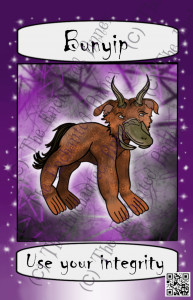 |
BunyipUse your integrityThe Bunyip (translated in Aboriginal Australian to mean devil or evil spirit), also known as the Kianpraty, is a creature of Aboriginal mythology. It lives in swamps, billabongs, creeks, riverbeds and waterholes all over Australia. Bunyip in the Wemba-Wemba language means “devil” or “Evil spirit”. Aboriginal peoples used to tell tales of Creatures that stalked the waterways and ate any prey item that come close, and the creatures had developed a taste for people, mostly children. Many of the modern sightings that have come from Australian people come in a wide variety of descriptions, scaly, furry, big, small, skinny, beefy and so on. One legend says that a man named Bunyip broke the Rainbow Serpent’s greatest law by eating his totem animal. Banished by the good spirit, Biami, the man became an evil spirit that lured tribesmen and their livestock into the water so he could eat all of them. One of the first recorded accounts of the bunyip took place in 1818, when James Meehan and explorer Hamilton Hume both found enormous bones in Lake Bathurst, located in New South Wales of Australia. They described the creature similar to a manatee or a hippopotamus. |
|
|
|
 |
ChupacabraHold on
|
|
|
|
 |
Cornish PiskieHumour with respect
|
|
|
|
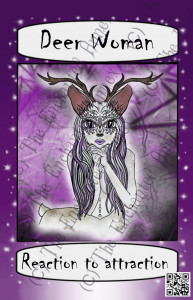 |
Deer WomanReaction to attractionAfter being asked by a lovely customer to advice her on this card & it’s meaning for her, she allowed me to share which then led me to giving you more information on THE DEER WOMAN On this particular occasion I was led to the Intuitive conclusion that, for her personally, sometimes people are as they appear, we don’t always need to be suspicious or cynical about them, especially potential sexual partners. This does not mean we should throw ourselves in head first but that trusting our instincts & being ourselves is the best course going forward. Having said that once you have read the information below you may conclude very differently. Sometimes known as the Deer Lady, is a shape-shifting woman in Native American mythology, in and around Oklahoma, the Western United States and the Pacific Northwest. She allegedly appears at various times as an old woman, or a young beautiful maiden, or a deer. Some descriptions assign her a human female upper body and the lower body of a white-tailed deer. The Deer Woman is said to sometimes be seen as a beautiful woman just off the trail or behind a bush, calling to men to come over. Deer Woman is often said to have all the features of a normal young woman, except her feet which are shaped like deer hooves and her brown deer’s eyes. Men who are lured into her presence often notice too late that she is not a natural woman and are then stomped to death. Other stories and traditions describe the sighting of Deer Woman to be a sign of personal transformation or a warning. Deer Woman is also said to be fond of dancing and will sometimes join a communal dance unnoticed leaving only when the drum beating ceases. According to Ojibwe tradition, she can be banished through the use of tobacco and chant others say that you can break her spell by looking at her feet, which are in fact hooves. Once she is recognized for what she is, she runs away. Although Deer Woman was usually considered a benign spirit who might help women conceive children, some stories portray her as a more dangerous being who might seduce men, especially adulterous or promiscuous men, and either lead them to their deaths or leave them to pine away from lovesickness. Among contemporary Native American people of Oklahoma, Deer Woman often plays a “bogeyman” sort of role, said to trample incautious people to death, especially girl-crazy young men or disobedient children. Some people say that this more violent version of Deer Woman is actually a human woman who either transformed into a deer after being raped, or was brought back to life by the original Deer Woman spirit after being murdered. Others say she is the same old Deer Woman, and just has a few good reasons to be in a worse mood these days! |
|
|
|
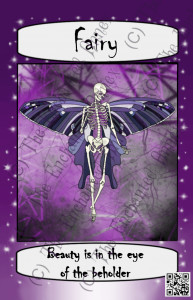 |
FairyBeauty is in the eye of the beholder
|
|
|
|
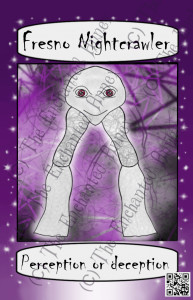 |
Fresno NightcrawlerPerception or deception
|
|
|
|
 |
GrootslangTreasures are closer than you thinkThe Grootslang or Grote Slang (Afrikaans and Dutch for “big snake”) is a legendary cryptid that is reputed to dwell in a deep cave in the Richtersveld, South Africa. According to legend, the Grootslang is a primordial creature as old as the world itself. Tales state that gods, new to the crafting of things, made a terrible mistake in the Grootslang’s creation, and gave it tremendous strength, cunning, and intellect. Realizing their mistake, the gods split the Grootslang into separate creatures and thus created the first elephants and the first snakes. But one of the original Grootslangs escaped, and from this first sire all other Grootslangs were born. It is claimed to devour elephants by luring them into its cave. The cave is known as the “Wonder Hole” or the “Bottomless Pit”. Supposedly, it connects to the sea which is 40 miles away. According to local legend, the cave is filled with diamonds. It is also said to live in warm rivers and lakes. In Benin, it is said to be a huge elephant-like creature with a serpent’s tail. Sometimes, it is depicted as a snake with orange gems for eyes. Also according to the tale, Grootslangs covet gems, particularly diamonds, and despite the creatures’ lust for cruelty, victims can often bargain for their freedom by offering a Grootslang enough precious gems. While searching for treasure in the richtersveld of South Africa in 1917, English businessman Peter Grayson disappeared after members of his party were attacked and injured by lions, prompting legends that the Grootslang had killed him. |
|
|
|
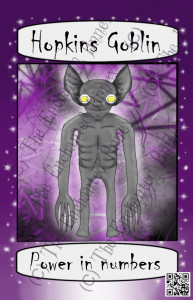 |
Hopkins GoblinPower in numbersOn August 21, 1955, the Kelly-Hopkinsville UFO incident terrified the people of western Kentucky and introduced the world to “little green men.” Fighting who? Apparently, little silver men. To some, the Kelly-Hopkinsville encounter provides compelling evidence of alien contact. Others see it as an overreaction ⏤ perhaps fueled by moonshine ⏤ to an owl attack. What’s certain is that the intrigue around the event has lingered. Today, the 300-odd citizens of nearby Kelly, Kentucky throw an annual “Little Green Men” Days Festival every August. The trope of aliens as “little green men” comes from the incident. And even Steven Spielberg drew inspiration from the encounter as he made E.T. So, what exactly happened on that 1955 summer night in Kentucky? |
|
|
|
 |
JackalopeBeware the meek
|
|
|
|
 |
Jersey DevilJudgementOn a dark and stormy night in 1735, something terrible happened in the Pine Barrens near Leeds Point. The thunder howled, and the wind roared outside. Inside a small house, Mother Leeds was giving birth to her 13th baby. No one knew for sure exactly what happened, but people had lots of ideas. This is one of the most popular stories about how the Devil was born, but there are many others. A different story says that a town put a curse on a young girl who fell in love with a British soldier during the Revolutionary War. When she gave birth, it was to the Jersey Devil. Another story says a gypsy cursed a girl because she didn’t give the gypsy food. The curse caused her to give birth to the Jersey Devil. Locals in the Pine Barrens call it the Leeds Devil. They say it has a horse’s head, long legs with hooves, two short front legs, and a bat’s wings. No one knows how tall it is. Some people think it’s six feet tall, others think it’s only three or four feet tall. The Devil has glowing red eyes and makes loud screeching sounds. It’s very ugly, and people are terrified after seeing it. During the day the Devil lives in the wetlands. At night it comes out to scare anyone it meets. More precisely, some scholars see the Jersey Devil as the folkloric offspring of an old political feud, one that involved Benjamin Franklin of all people. Here’s the story. Today, there’s a friendly north-south rivalry inside New Jersey’s borders but during the late 17th and early 18th centuries, things were different. The British-held colony that became the modern state of New Jersey was split somewhat vertically into “East Jersey” and “West Jersey.” In 1687, Leeds published the first edition of his very own almanac. This became a lightning rod for controversy; many Quakers who read the text objected to its use of astrology and “heathen” Greco-Roman planet names. When Quaker leadership turned against Leeds, he went on the offensive. The pamphleteer befriended anti-Quaker politicians and wrote a 1699 manifesto denouncing Quaker theology titled “A Trumpet Sounded Out of the Wilderness of America.” Bridges were burned. One prominent Quaker, Caleb Pusey, took aim at Leeds by writing a pamphlet that called him “Satan’s harbinger.” |
|
|
|
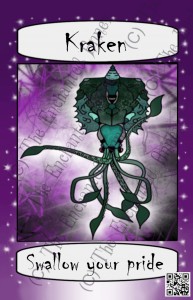 |
KrakenSwallow your prideThe great leviathan of the deep originating in Scandinavian folklore, the kraken is usually depicted as an aggressive cephalopod-like creature capable of destroying entire ships and dragging sailors to their doom. In ancient Greece, Aristotle and Pliny wrote about teuthos (squid). There’s the Scylla in the Odyssey and similar myths from the Caribbean (Lusca), Japan (Akkorokamui) and New Zealand (Te Wheke-a-Muturangi). Hades states that the Kraken is his child and only he is feeding off the destruction. Zeus tries to remind him who’s in charge, but Hades uses his power to halt Zeus, which is enough to weaken the God King. Hades asserts that he serves no one, especially after Zeus wrongfully banished him to the Underworld. What is believed happened in reality is that the partially digested or rotted remains of giant squid and large octopus were washing up on beaches and people were starting to guess what they might be. In Norway, the kraken myth grew and such washed-up specimens were interpreted as messages from God or the Devil, sometimes called sea angels, sea devils or sea monks. These things happened separately and people around the world came up with similar answers and mythologies – a case of convergent evolution in myth form. |
|
|
|
 |
LilituEmbrace freedom
|
|
|
|
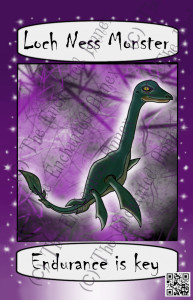 |
Loch Ness MonsterEndurance is key
|
|
|
|
 |
Mongolian Death WormDon’t lose yourself
|
|
|
|
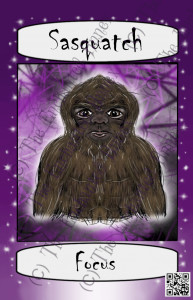 |
SasquatchFocusSasquatch is said to be a large, ape-like creature that lives primarily in the forests stretching from the West Coast of British Columbia to Northern California, and to a lesser extent throughout North America. Sasquatch is a cryptid — a creature whose existence is suggested, but has not yet been confirmed by the scientific community. Like the Yeti of Asia or the Abominable Snowman of the Himalayas, Sasquatch is rooted in Indigenous legend and is commonly researched by cryptozoologists and enthusiasts. Some believe Sasquatch is a nearly extinct species of hominid that survives in isolation, while others consider the creature to be the product of folklore and a hoax.
Sasquatch is often described as bipedal, measuring up to 2.75 m in height and 360 kg in weight, and covered in long dark hair. Its footprints are said to measure up to 50 cm. Plaster casts of what are said to be Sasquatch tracks are often offered as proof of its existence, though the authenticity of such tracks is highly disputed. Film footage shot in 1967 that purports to show Bigfoot running through the woods near Bluff Creek, California, is perhaps the most famous evidence offered of the cryptid by its proponents. There has been no documented discovery of Sasquatch remains. |
|
|
|
 |
Shadow PeopleWatch and learnShadow people usually, but not always, begin to appear initially as fleeting images in a person’s peripheral vision. However, at higher levels of intensity shadow people may begin to appear in full view in a manner which allows them to be directly looked at. At advanced mental states, it is even possible to look away from and look back at the shadow person without a change in the presence or appearance of the hallucination. The bodies of these shadow people are usually perceived as being comprised of a type of blackness that has a sense of depth with few facial or bodily features. The blackness of their bodies often seem almost opaque, as if one is looking into a “black hole” in humanoid form. They may also appear in the shape of animals, uniform blobs, disembodied body parts, or a myriad of other indescribable shapes. They sometimes appear to have faces, eyes, or mouths and are able to move or change shape. The movement exhibited can be normal human movement or it can be faster, slower, or more choppy than a normal person’s gait. It is also possible for multiple shadow people to occupy one’s field of vision simultaneously while acting autonomously from one another and even interacting with each other. It is worth noting that the style and general behaviour of a shadow person are often largely dependent on the emotional state of the person experiencing it. For example, a person who is emotionally stable and generally happy will usually be more prone to experiencing neutral, interesting, or friendly shadow people. In contrast, however, a person who is emotionally unstable and generally unhappy will usually be more prone to experiencing sinister and fear-inducing shadow people. |
|
|
|
 |
SirenSeduction
|
|
|
|
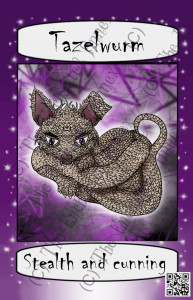 |
TazelwurmStealth and cunning
|
|
|
|
 |
ThunderbirdVengeance at cost
|
|
|
|
 |
WendigoNeeds must be met
|
|
|
|
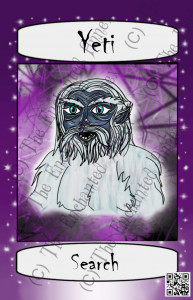 |
YetiSearch
|
|
|
|

 The word Sasquatch is believed to be an Anglicization of the Salish word Sasq’ets, meaning “wild man” or “hairy man.” J.W. Burns coined the term in the 1930s. Burns was an Indian agent assigned to the Chehalis Band, now known as the Sts’ailes First Nation. The Sts’ailes people claim a close bond with Sas’qets, and believe it has the ability to move between the physical and spiritual realm. Sasquatch has also been commonly known as Bigfoot in the Pacific Northwest of the United States.
The word Sasquatch is believed to be an Anglicization of the Salish word Sasq’ets, meaning “wild man” or “hairy man.” J.W. Burns coined the term in the 1930s. Burns was an Indian agent assigned to the Chehalis Band, now known as the Sts’ailes First Nation. The Sts’ailes people claim a close bond with Sas’qets, and believe it has the ability to move between the physical and spiritual realm. Sasquatch has also been commonly known as Bigfoot in the Pacific Northwest of the United States.